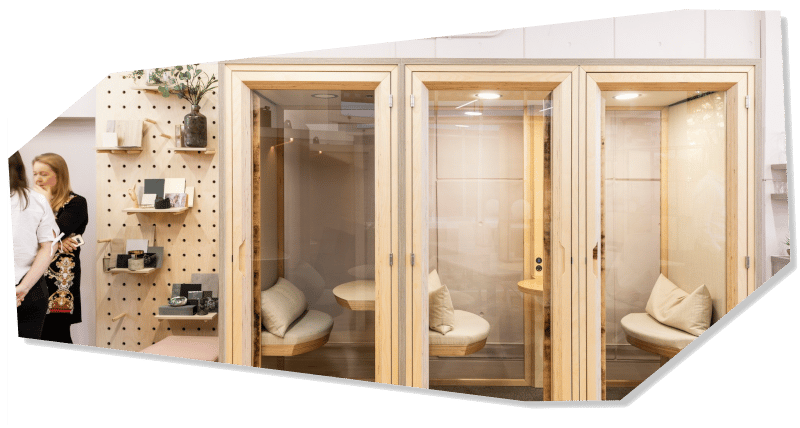Realising the benefits of Activity-Based Working
Activity-based working involves optimising the design of your office to suit the range of activities your workforce undertakes. This means creating a series of carefully considered work environments that each suit different workday activities, while also instilling this sense of flexibility within your workforce. ABW offers a compelling range of benefits for businesses when implemented effectively:
Optimised people and business performance
Businesses that adopt an ABW-led office strategy report enhanced collaboration between teams and individuals. By providing spaces that promote better communication and teamwork, as well as supporting concentrated individual work when needed, the organisation sees dramatic improvements in productivity, effectiveness and ultimately business performance.
Engaging workspaces that drive employee effectiveness
Performance improves when businesses provide employees with workspaces that work for them. ABW increases workforce productivity and performance by making it easy for your people to carry out the variety of tasks their day requires. This leads to increased employee satisfaction and engagement, making the office a more effective hub for your business.
Maximising impact with space utilisation
Space utilisation involves optimising the space you use to maximise its impact, removing underutilised and inefficient space and rationalising your property costs. Activity-based working moves us away from over-reliance on the individual desk – which research shows are only utilised for 50% of the working day – and re-works the additional space freed up to provide a comprehensive range of workstations, hubs, and amenities for a variety of tasks and activities.
Futureproofing Workspaces
By maximising the flexibility of your office space design and the way it’s used, activity-based working strategies offer a long-term design solution. With a flexible workplace design that can adapt as your business evolves, the business is able to keep refining the space over time. Workplace design consultations can be periodically carried out after you have adopted activity-based working, ensuring your office is continuously optimised to achieve the best results for years to come.
Promoting wellbeing
From a health and wellbeing perspective, increasing opportunities for employees to move around the workplace can have a profound positive impact. Office employees are traditionally used to spending all day at their desks, which can have a negative impact on energy levels and concentration among other things. Solutions such as the standing desk and the treadmill desk can help mitigate these problems, but an office that encourages movement and a different way of using the space is a better way to address the issue at its core.
Envisioning an activity-based workspace
No two offices that have adopted activity-based working practices look the same. This is because each organisation has individual needs and unique employees. The layout and structure that works for one office is entirely different to what works for another.
Adaptable, dynamic spaces
ABW environments feature highly dynamic spaces that encourage more flexible behaviours from employees, too. The ability to adjust workspaces as each activity ensues also gives employees a greater sense of control over their surroundings, promoting wellbeing and job satisfaction. This can foster creativity, bringing more innovative ideas to your business. With multifunctional areas designed to account for a range of activities, modular furniture that adapts to suit each day is popular.
A strong sense of community
In ABW scenarios, employees are free to move around the office, selecting the working environment that suits their activity best. This leads to higher levels of engagement with colleagues in alternative roles, thus feeding into a stronger sense of community and office culture within the workplace.
Encouraging ABW with behavioural cues
Behavioural cues can be key to helping the workforce seamlessly integrate ABW practices into their everyday routine. In activity-based workplaces, you’ll find plenty of signage directing employees to various ‘stations’ within the office. These encourage the effective use of each space, while also prompting the natural flow of employees through the office as they go about their day.
Diversifying the workspace with a range of settings
Alongside the general ‘feel’ of an activity-based workspace, there are physical elements that many workspaces benefit from including. Offering a diverse mixture of rooms, amenities, lounges and quiet areas ensures there’s always somewhere to suit everyone.
The exact configuration of spaces and amenities will depend on the needs of your own workforce. There is no ‘one size fits all’ approach to implementing activity-based working spaces. The following range of solutions provides a good place to start:
Quiet spaces & focus rooms
As the prevalence of remote working grows, providing quiet spaces for taking video calls and meetings is vital. These spaces make use of adaptable furniture so space is utilised to its full potential, with quiet areas transforming into focus rooms where in-person, 1-to-1 conversations can happen too.
Conference rooms
Conference spaces are still key for meetings, though they’ll be revitalised to serve more than just one purpose. They might contain flexible equipment that transforms the room into a creative studio, or a team-based exercise as needed.
Work lounges & amenities
Keeping the workspace comfortable with home-like amenities draws the workforce back into the office. With functional yet aesthetic areas that support the free movement of employees around the office, spaces are less likely to become congested.
Collaboration zones
In any office, collaboration is key. Dedicated zones for communal work allow employees to communicate and work more effectively – together.
Huddle booths
Huddle zones for smaller discussions within teams might be dotted around the office, strategically positioned to support the movement of employees as they go about their day.
Cafeterias & open cafes
The classic office cafeteria is not lost. It remains an integral space where meals and breaks are catered for. These spaces can be curated to suit the mood of your office. For example, a relaxed atmosphere where employees can switch off and chat over lunch – taking their break away from their work.
Project rooms
In offices where certain equipment is required across projects, the process can be streamlined with dedicated project rooms that provide everything needed to complete the task efficiently. For example, all the tech required to fulfil tasks within one working space. This means employees won’t waste time traversing the office to find equipment.
Open plan & individual desks
The desk is still very much alive and well as a work setting, but with more flexibility for employees to use as and when best suits their work routine. Provision of open-plan desks and individual desks is restructured to account for actual occupation patterns, allowing for flexible working, hotdesking and hoteling.
How Office Workspace can help
The first step as simple as having an informal chat with one of our workspace team, to find out a bit more about your business and your drivers for change.
To find out more about how we can help you to innovate the way you work, get in touch by emailing hello@officeworkspace.com or calling +44 (0)20 8039 0000. You can also fill out our online contact form, and we’ll get back to you as soon as possible.

